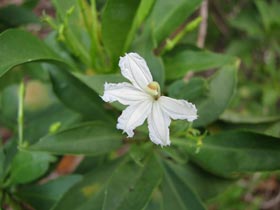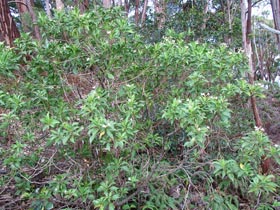Scaevola gaudichaudiana
Genus
Scaevola
Species
gaudichaudiana
Hawaiian Names with Diacritics
- Naupaka
- Naupaka kuahiwi
Hawaiian Names
- Naupaka
- Naupaka kuahiwi
Common Names
- Mountain naupaka
Synonyms
- Scaevola chamissoniana var. pubescens
- Scaevola ciliata
- Scaevola ligustrifolia
- Scaevola pubescens
- Scaevola skottsbergii
- Temminckia ciliata
Distribution Status
Endemic
Endangered Species Status
No Status
Plant Form / Growth Habit
- Shrub
- Tree
Mature Size, Height (in feet)
- Shrub, Small, 2 to 6
- Shrub, Medium, 6 to 10
- Tree, Small, 15 to 30
Mature Size, Width
Naupaka kuahiwi has a spread that is 8-10 feet.
Life Span
Long lived (Greater than 5 years)
Landscape Uses
- Accent
- Container
- Hedges
Additional Landscape Use Information
This naupaka kuahiwi is as not as easy to grow and maintain in the landscape as its drier growing cousins (S.coriacea, S. gaudichaudii, S. sericea). But, it is not difficult either and should be grown more.
It grows as a dense well formed shrub and does well under tall trees and shrubs.
People often plant coastal naupaka kahakai on the makai side of the house and naupaka kuahiwi on the mauka side. [Rick Barboza, Hui Kū Maoli Ola]
Comapanion Plants:
Koa, ʻōhiʻa, kōlea, kōpiko, ʻiliahi, olopua, māmaki, pilo, and hāpuʻu.*
_____
* These plants can be found on this website using the "Browse Plants" feature found at the top. Enter names without diacritics.
Source of Fragrance
- Flowers
Additional Fragrance Information
Flowers have a pleasant fragrance that will command your attention. One colorful description of the flower scent is like the breakfast cereal Trix!
Plant Produces Flowers
Yes
Flower Type
Showy
Flower Colors
- White
Additional Flower Color Information
Naupaka kuahiwi has fragrant white tubular flowers that are showy en masse.
Blooming Period
- Year Round
- Sporadic
Additional Blooming Period and Fruiting Information
Small purple fruits follow flowering.
Plant texture
- Fine
- Medium
Additional Plant Texture Information
Leaves of naupaka kuahiwi have toothed margins.
Leaf Colors
- Light Green
- Medium Green
Additional Pest & Disease Information
Naupaka kuahiwi is prone to ants, scale, aphids and mealy bugs. Slugs and snails may harm young plants but usually do not infest larger ones.
Fertilizer
Apply a balanced slow release fertilizer with minor elements every six months. Foliar feed monthly with a kelp or fish emulsion, or a water-soluble fertilizer with a dilution of one-half to one-third of the recommended strength. [David Eickhoff, Native Plants Hawaiʻi]
Pruning Information
None necessary except to remove dead material.
Water Requirements
- Moist
Additional Water Information
This naupaka kuahiwi prefers moist conditions but can tolerate wet conditions as well. Out plant this naupaka kuahiwi in moist to wet conditions which are similar to its wild habitat
Soil must be well drained
Yes
Light Conditions
- Partial sun
- Shade
Additional Lighting Information
Naupaka kuahiwi do best with some shade, especially at midday and afternoon sun, and requiring about half a day of sun. It can be grown in full sun in cloudy, rainy sites. [5]
Soils
- Cinder
- Organic
Limitations
The wetter growing mountain species of naupaka kuahiwi have more sensitive needs in the landscape than the dry or coastal growing naupaka and require additional care and monitoring after out planting.
Probably not tolerant of salty environments and excessive heat. [5]
Natural Range
- Kauaʻi
- Oʻahu
Natural Zones (Elevation in feet, Rainfall in inches)
- 150 to 1000, Greater than 100 (Wet)
- 1000 to 1999, Greater than 100 (Wet)
- 2000 to 2999, Greater than 100 (Wet)
Habitat
- Terrestrial
Additional Habitat Information
Naupaka kuahiwi grows in wet forest and open areas from about 555 to over 2,600 feet.
Scaevola gaudichaudiana is known to hybridize with Scaevola mollis where their ranges overlap. The hybrid is known as Scaevola x cerasifolia. It is a beautiful naupaka with desirable qualities of each parent.
![]() Special Features and Information
Special Features and Information
General Information
Ten species of naupaka (Scaevola spp.) are native to the Hawaiian Islands in the Goodenia family or Goodeniaceae.
Etymology
The generic name Scaevola is derived from the Greek scaevus, left-handed or awkward, perhaps in reference to the "awkward" appearance of the "half flower."
The specific epithet gaudichaudiana is named after the French botanist Charles Gaudichaud-Beaupré (1789-1854) who made several contributions to the knowledge of Hawaiian flora during his voyages to the islands.
Hawaiian Name:
Six upland species of Scaevola share the Hawaiian name naupaka kuahiwi which means "naupaka of the mountains."
Background Information
The Legend:
In ancient times, one version goes, there was a beautiful Hawaiian princess known as Naupaka. One day, the villagers noticed that Naupaka looked very sad. They told her parents, who approached Naupaka and asked her what was troubling her.
“I have fallen in love with a man named Kaui,” replied the princess. “But Kaui is not of noble birth—he is a commoner.” According to Hawaiian tradition, it was strictly forbidden for members of royalty to marry people from the common ranks.
Distressed, Naupaka and Kaui traveled long and far, seeking a solution to their dilemma. They climbed up a mountain to see a kahuna who was staying at a heiau (temple). Alas, he had no clear answer for the young lovers. “There is nothing I can do,” he told them, “but you should pray. Pray at this heiau.”
So they did. And as they prayed, rain began to fall. Their hearts torn by sorrow, Naupaka and Kaui embraced for a final time. Then Naupaka took a flower from her ear and tore it in half, giving one half to Kaui. “The gods won’t allow us to be together,” she said. “You go live down by the water, while I will stay up here in the mountains.”
As the two lovers separated, the naupaka plants that grew nearby saw how sad they were. The very next day, they began to bloom in only half flowers.
There are different versions of the naupaka legend, but all carry the same unhappy theme: lovers that are separated forever, one banished to the mountains, the other to the beach. [4]
Early Hawaiian Use
Dyes:
The fruits of naupaka kuahiwi produced a purplish black dye. [1,3]
Lei:
The fragrant flowers were used in lei making. [2]
Additional References
[1] "Plants in Hawaiian Culture" by Beatrice H. Krauss, page 66.
[2] "Nā Lei Makamae--The Treasured Lei" by Marie A. McDonald & Paul R. Weissich, page 99.
[3] "In Gardens of Hawaii" by Marie C. Neal, pages 819-820.
[4] Aloha-Hawaii http://www.aloha-hawaii.com [Accessed 12/14/12]
[5] "How to Plant a Native Hawaiian Garden" by Kenneth M. Nagata, page "Naupaka kuahiwi."
PHOTOS FOR THIS SPECIES CAN BE SEEN AT THE LINK (Copy & Paste to your browser):
https://www.flickr.com/search/?user_id=50823119%40N08&sort=date-taken-desc&view_all=1&text=Scaevola%20gaudichaudiana
Plant Gallery
Back to Plant List
Other Nursery Profiles for Scaevola gaudichaudiana



